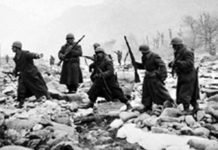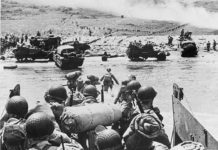The Victoria Cross formerly known as the Imperial Victoria Cross was originally created by Queen Victoria for acts of bravery during wartime
The Australian public, including servicemen and women consider the Victoria Cross (Australia) to be the penultimate military award. The Australian Government Victoria Cross information facts sheet states the medal is for a daring or pre-eminent act of valour or self-sacrifice; or extreme devotion to duty. Awarded to persons who, in the presence of the enemy, display the most conspicuous acts of gallantry. Since its inception in 1991 there have been just two Australian recipients of the award.
The original Imperial Victoria Cross award was created in 1856. However Queen Victoria deemed it appropriate to backdate the awards to ensure that men who had fought in the Crimean War if it were appropriate would receive the cross.
A British Medal Cast from Russian Canon
Each medal is cast from the bronze of capture Russian canons. Each time a medal is required a piece of bronze is chipped from one of the canons, now house in the Tower of London. Cast in the shape of a Maltese Cross the crosses are backed by a single crimson ribbon. The obverse of the Victoria Cross bears a crowned lion standing on a royal crown with the words For Valour inscribed on a semicircular scroll beneath the crown. The reverse of the cross is engraved with the date of the act of gallantry and the name, rank and unit of the recipient. The cannons captured during the Crimea War have become a living symbol to soldiers throughout the British Empire and beyond.
Queen Victorias Legacy
The Princess Victoria, only child of Edward Duke of Kent, son George 111 and Princess Victoria Saxe-Coburg-Saalfeld was born at Kensington Palace, on 24th of May 1819. In 1837 at the death of her uncle King William 1V, the young Victoria at the tender age of 18 years became Queen. Monarch of the United Kingdom and Great Britain, she would rule her kingdom for nearly 64 years. At her death on 22nd January1901 it was said that Britain had a world wide empire on which the sun never set. This longest reigning monarch left behind innumerable legacies and the Imperial Victoria Cross is arguably one of the greatest. Created in 1856 the Imperial Victoria Cross was made retrospective to 1854 to enable the award to cover the Crimean War.
In the Company of Brave Men
Since its inception in 1856 there have been ninety six Australians have been recipients of the Imperial Victoria Cross. Men like Lance Corporal Thomas Lesley Axford born in Carrieton South Australia was working in Kalgoolie Western Australia when he enlisted. Many Australians including Axford felt it their duty to enlist to fight for king and country. Landing in France in 1916 Axford saw first hand much of the misery of war. During his time in the trenches Axford was, like a number of other soldiers treated for shell shock. In early 1918 he was awarded the Military Medal. However his finest hour was to come on the 4th of July 1918 when he was awarded the Imperial Victoria Cross for action undertaken on the field of battle. He is credited as saying “I must have been made mad” when during the battle of Hamel, Lance Corporal Axford assisted another platoon by attacking an enemy machine gun position with bombs and bayonets resulting in the death of ten Germans and the capture of six others. This valiant act of personal bravery allowed the platoon to come forward and join him in the advance.
A Measure of Courage
Ninety six Australians have received awards in the following conflicts. Ninety One awards were for personnel serving in the Australian forces, with six awards for personnel serving with South African and British units.
- 6 in the Boer War 1899-1902
- 64 in World War I 1914-1918 (The Great War)
- 2 in North Russia 1919
- 20 in World War II 1939-1945
- 4 in Vietnam 1962-1972
The first Australian recipient of the Imperial Victoria Cross was Captain Sir Neville Howse VC KCMG CB KStJ for valour during the Boer War (1900). He also served in World War I and later as Commonwealth Minister for Health, Defence and Repatriation.
The last recipient of the Imperial Victoria Cross was Warrant Officer Keith Payne VC for gallantry during the Vietnam War (24th May 1969). Under heavy fire, Warrant Officer Payne instigated a rescue of more than forty men, many of whom were wounded. Payne then led the party including the wounded back to the battalion base.
A Change of Name
The Imperial Victoria Cross UK was about to change. Until 1991 eligible Australians were awarded the Imperial Victoria Cross and/or other awards under the Imperial system of honours. The Victoria Cross for Australia was instituted in the Australian honours system by Letters Patent on 15 January 1991. Instituted to replace the British Imperial Victoria Cross, the Australia award was created specifically for Australians formerly eligible for the Victoria Cross and other awards under the Imperial system of honours.
The first Victoria Cross for Australia was awarded to Trooper Mark Donaldson on 16th January 2009 for action in Afghanistan, Trooper Donaldsons was then joined As a recipient of the Victoria Cross Australia by Corporal Benjamin Roberts-Smith VC MG who received his award on 23 January 2011.
N.B. Whilst there have been only two recipient there are currently 13 application awaiting an outcome.
How the Victoria Cross is Awarded
Medals are awarded on the recommendation of the Minister for Defence. The Governor General for Australia and with the approval of the sovereign then awards the Victoria Cross for Australia. The Victoria Cross can be awarded posthumously and a number of current applications pending would fall within the posthumous category.








